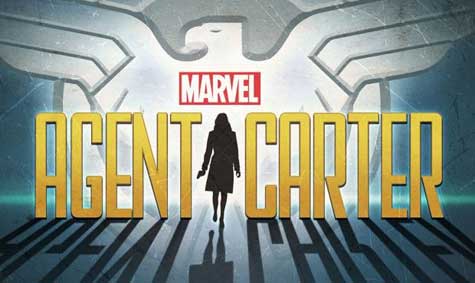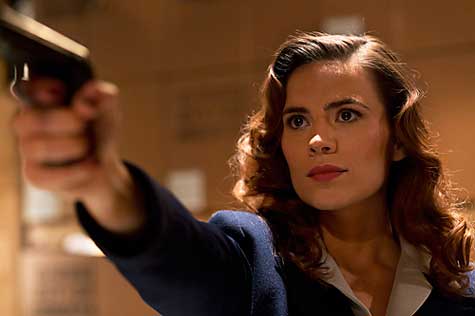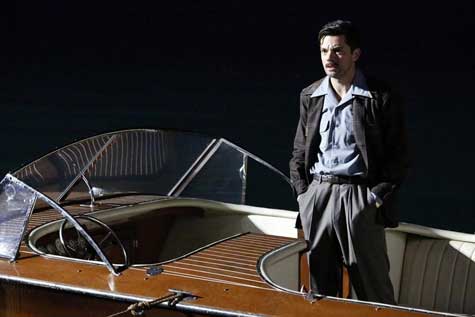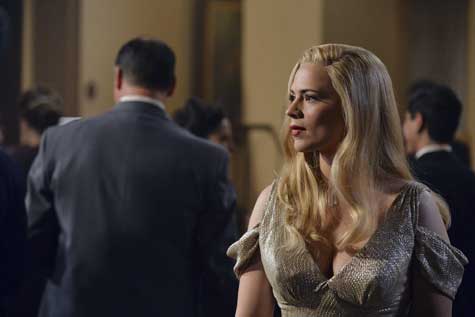
First, a confession: I am Agent Carter’s ideal audience. One, I like women who kick ass. Two, my grandmother was an English lass who endured World War II, met a nice soldier from Texas, married him and moved to the US, so I dig English ladies who kick ass. Three, I’m a lifelong fan of Captain America and the whole universe of super-powered espionage that surrounds him, including the formidable Agent Carter. Four, Hayley Atwell, because I would watch Hayley Atwell do pretty much anything.
So, yes, I was on board with this show before it came out, but I was a little nervous because you never know how these things will pan out. I’m happy to report, though, that the show (slated for eight episodes) is a hell of a lot of fun.
The first episode, “Now Is Not The End”, kicks off with the ending of Captain America: The First Avenger, as the good Captain Rogers flies a plane loaded with explosives into the freezing ocean. On the other end of his radio communication is his fellow solider, Agent Peggy Carter. They’ve been in love practically since they met, back when he was still a skinny, sickly recruit with nothing going for him except innate decency and gumption, yet they’ve never gotten together. In keeping with the reserved nature of their relationship, they don’t declare undying love for each other as Steve is about to (apparently) die. They make plans for a date. She promises to teach him to dance. Then he crashes and is gone from her life.

Since Agent Carter starts this way, a word about the movie is necessary. One of the things that makes the Captain America series the most compelling in the whole Marvel movie universe is its undercurrent of melancholy. The First Avenger has a coda in which Steve Rogers wakes up in the present day, resurrected, it would seem, from the dead. He’s asked if he’s going to be okay, and he answers, in the movie’s final line, “Yeah…it’s just…I had a date.” That final moment—the sense of a life interrupted—is the key to his character over the rest of the films.
Agent Carter picks up that same tone and runs with it. Peggy finds herself at loose ends after the war, a little lost without Steve and their shared mission to defeat Hydra and the Nazis. It’s 1946 and she’s working for the Strategic Scientific Reserve, the forerunner to S.H.I.E.L.D. Although she was more or less running the Allies’ war effort in The First Avenger, after the war she’s been shunted aside in favor of a boys club. These early scenes evoke postwar gender dynamics, as women were expected to surrender their jobs to returning soldiers. We associate the Baby Boom with these years, but it’s always important to remember that it was a time of incredible stress and upheaval. The entire world had been traumatized, the economy tanked as all the munitions jobs disappeared, and the women who had been the backbone of the homeland war effort were told to go home and have babies. (There is a reason that film noir flourished in the mid-40s.)
It will have to be admitted that Agent Carter is a little hamfisted in dealing with these issues. Peggy’s coworkers are a bunch of louts who seem like extras from the first season of Mad Men, and it’s a little odd that no one around her seems to be aware at all that she helped save the world. The show does explain away this last problem, though, by telling us that Peggy’s participation in the war has been historically relegated to the status of “Captain America’s girlfriend,” a theme that will pop up again in the second episode. Despite the heavy-handed way the show goes about it, what Agent Carter is doing here is interesting—giving us a metaphor for the way women’s lives are interpreted (and reinterpreted) in the culture.

The plot of the first episode finds Carter trying to clear the name of her former comrade in arms, military industrialist Howard Stark (Dominic Cooper). In a clear nod to the Red Scare and the HUAC hearings, Stark is under investigation by Congress. The boys on Capitol Hill just want his technology to develop weapons and since Stark won’t play ball they want to throw him in jail. Before he goes on the run, he pairs up Carter with his butler Edwin Jarvis (Edwin D’Arcy) and the two set out to run espionage under the noses of Peggy’s loutish bosses and coworkers, all of whom just want to catch Stark.
Peggy’s investigation leads her to a shady underworld figure named Spider Raymond (Andre Royo) who, in the grand noir tradition, runs a nightclub. Peggy sneaks into the place in a blonde wig and a husky American accent—this whole nightclub sequence reminded me of the 1947 Lizabeth Scott noir Dead Reckoning—kisses Raymond with some special lipstick that knocks him out and then steals a glowing ball that, as I followed it, is some kind of super-secret weapon developed by Stark. After a few underwhelming initial action scenes early in the episode, the show heats up when Peggy has to fight a mysterious assailant in her apartment. It’s a hell of a great fight, well choreographed and played in close quarters (reminding me a bit of the big fight in The Bourne Ultimatum). Peggy wins and the guy runs off.

All in all, a fun first episode. The show sets several plates spinning, gives Peggy some personal drama, and culminates in some top-shelf fisticuffs. I like where this thing is going.
Jake Hinkson is the author of several novels, including the newly-released The Big Ugly.
Read all of Jake Hinkson's posts for Criminal Element.

PS: I should also say that Agent Carter inspired a [url=http://marvel.com/videos/watch/2814/marvel_one-shot_agent_carter_-_clip_1]One Shot spin off short [/url]from Marvel that was included on the Iron Man 3 Blu-Ray.